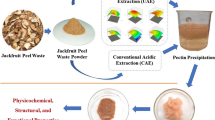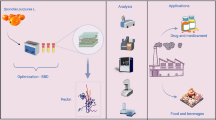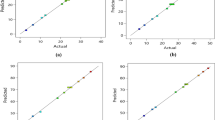Abstract
The industrial thirst for sustainable pectin sources could be satisfied by the adoption of waste biomass from banana cultivation as a potential source. The implementation of Musa balbisiana pseudostem for ultrasound-mediated pectin extraction was scrutinized and optimized by response surface methodology. The significant factors employed in ultrasonication were sonication time (10–30 min), pH (1–2.5), solid–liquid ratio (1:10–1:20 g/ml), and temperature (35–75 °C). The optimization results implicate that the highest yield of pectin is 15.10% and the degree of esterification is 59.46% when experimented with a 1:20 g/ml solid–liquid ratio, pH 1.0 for 20 min sonication at 65 °C. Among the six extraction kinetic models, logarithmic model was the best fit to describe the pectin extraction kinetics with significant 0.9639 R2 and 1.085 RMSE values. The extracted pectin from the banana pseudostem was compared with commercial citrus pectin in terms of FTIR, XRD, and TGA to estimate the functional groups, crystallinity, and thermal properties. FTIR and thermal analysis of ultrasound-mediated extracted pectin infer correlation of molecular distribution and sequential arrangement of molecules with commercial pectin. The extracted pectin's equivalent weight, methoxyl content, and anhydrouronic acid were high, which corresponds to the extracted pectin's gelling ability and binding capacity. The intrinsic viscosity, relative viscosity, and molecular weight of the banana pseudostem-extracted pectin determined as 4.15%, 1.41, and 211.84 kDa were found to be significant. This research suggests the positive feedback of pseudo-banana stem for extracting pectin by ultrasonication as novel and efficient technology.
Graphical abstract






Similar content being viewed by others
Data availability
The data material used and analyzed during the current study is available from the corresponding author upon request during publications.
References
Balakrishnan S, Wickramasinghe GLD, Wijayapala US (2019) Investigation on improving banana fiber fineness for textile application. Text Res J. https://doi.org/10.1177/0040517519835758
Subash MC, Perumalsamy M (2022) Enzymatic degumming of banana fibers by enterobacter cloacae PMC04 for fineness improvisation: an eco-friendly approach. J Nat Fibers 00:1–18. https://doi.org/10.1080/15440478.2022.2048937
Poondla V, Yannam SK, Gummadi SN et al (2016) Enhanced production of pectinase by Saccharomyces cerevisiae isolate using fruit and agro-industrial wastes: Its application in fruit and fiber processing. Biocatal Agric Biotechnol 6:40–50. https://doi.org/10.1016/j.bcab.2016.02.007
Li W, Zhang Y, Li J et al (2015) Characterization of cellulose from banana pseudo-stem by heterogeneous liquefaction. Carbohydr Polym 132:513–519. https://doi.org/10.1016/j.carbpol.2015.06.066
Kohli P, Gupta R (2019) Application of calcium alginate immobilized and crude pectin lyase from Bacillus cereus in degumming of plant fibres. Biocatal Biotransform. https://doi.org/10.1080/10242422.2018.1564745
Silva J, Leonardo H, Brito L (2022) Environmental performance of orange citrus waste production. Food Bioprod Process 135:165–177. https://doi.org/10.1016/j.fbp.2022.07.008
Patience NA, Schieppati D, Boffito DC (2021) Continuous and pulsed ultrasound pectin extraction from navel orange peels. Ultrason Sonochem 73:105480. https://doi.org/10.1016/j.ultsonch.2021.105480
Filho LBS, Coelho RC, Muniz EC, de Barbosa HS (2022) Optimization of pectin extraction using response surface methodology: a bibliometric analysis. Carbohydr Polym Technol Appl 4:100229. https://doi.org/10.1016/j.carpta.2022.100229
Mohnen D (1999) Biosynthesis of pectins and galactomannans. In: Barton D, Nakanishi K, Meth-Cohn O (eds) Comprehensive Natural Products Chemistry Science Amsterdam, vol 3, pp 497–527
Lad A, Yang Y, Ghani R, Kisiel B (2009) Toward optimal ordering of prediction tasks. In: Proceedings in applied mathematics—9th SIAM international conference on data mining 2009, vol 2. Society for Industrial and Applied Mathematics, pp 879–888. https://doi.org/10.1137/1.9781611972795.76
Lara-Espinoza C, Carvajal-Millán E, Balandrán-Quintana R et al (2018) Pectin and pectin-based composite materials: beyond food texture. Molecules. https://doi.org/10.3390/molecules23040942
Fan P, He F, Yang Y et al (2015) In-situ microbial degumming technology with Bacillus sp. HG-28 for industrial production of ramie fibers. Biochem Eng J 97:50–58. https://doi.org/10.1016/j.bej.2014.12.010
Sundarraj AA, Thottiam Vasudevan R, Sriramulu G (2018) Optimized extraction and characterization of pectin from jackfruit (Artocarpus integer) wastes using response surface methodology. Int J Biol Macromol 106:698–703. https://doi.org/10.1016/j.ijbiomac.2017.08.065
Sanjay MR, Arpitha GR, Naik LL et al (2016) Applications of natural fibers and its composites: an overview. Nat Resour 07:108–114. https://doi.org/10.4236/nr.2016.73011
Siew CK, Williams PA, Cui SW, Wang Q (2008) Characterization of the surface-active components of sugar beet pectin and the hydrodynamic thickness of the adsorbed pectin layer. J Agric Food Chem 56:8111–8120. https://doi.org/10.1021/jf801588a
Dranca F (2019) Ultrasound-Assisted extraction of pectin from Malus domestica ‘Fălticeni’ Apple Pomace. Processes 7:488
Srivastava P, Malviya R (2011) Sources of pectin, extraction and its applications in pharmaceutical industry—an overview. Indian J Nat Prod Resour 2:10–18
Pinheiro VE, Michelin M, Vici AC et al (2020) Trametes versicolor laccase production using agricultural wastes: a comparative study in Erlenmeyer flasks, bioreactor and tray. Bioprocess Biosyst Eng 43:507–514. https://doi.org/10.1007/s00449-019-02245-z
Shivamathi CS, Moorthy IG, Kumar RV et al (2019) Optimization of ultrasound assisted extraction of pectin from custard apple peel: Potential and new source. Carbohydr Polym 225:115240. https://doi.org/10.1016/j.carbpol.2019.115240
Kirti Bhushan Z, Anil SM, Sainand K et al (2007) Comparison between different methods of waste oil recovery. Int J Innov Res Sci Eng Technol 3297:20001–20009. https://doi.org/10.15680/IJIRSET.2016.0511062
Picot-Allain MCN, Ramasawmy B, Emmambux MN (2020) Extraction, characterisation, and application of pectin from tropical and sub-tropical fruits: a review. Food Rev Int 00:1–31. https://doi.org/10.1080/87559129.2020.1733008
Shah HUR, Ahmad K, Bashir MS et al (2022) Metal organic frameworks for efficient catalytic conversion of CO2 and CO into applied products. Mol Catal 517:112055. https://doi.org/10.1016/j.mcat.2021.112055
Shah HUR, Ahmad K, Naseem HA et al (2021) Synthetic routes of azo derivatives: a brief overview. J Mol Struct 1244:131181. https://doi.org/10.1016/j.molstruc.2021.131181
Mao G, Wu D, Wei C et al (2019) Reconsidering conventional and innovative methods for pectin extraction from fruit and vegetable waste: targeting rhamnogalacturonan I. Trends Food Sci Technol 94:65–78. https://doi.org/10.1016/j.tifs.2019.11.001
Venkatanagaraju E, Bharathi N, Hema Sindhuja R et al (2020) Extraction and purification of pectin from agro-industrial wastes. Pectins Extr Purif Charact Appl. https://doi.org/10.5772/intechopen.85585
Mada T, Duraisamy R, Guesh F (2022) Optimization and characterization of pectin extracted from banana and papaya mixed peels using response surface methodology. Food Sci Nutr 10:1222–1238. https://doi.org/10.1002/fsn3.2754
Saberian H, Hamidi-Esfahani Z, Ahmadi Gavlighi H, Barzegar M (2017) Optimization of pectin extraction from orange juice waste assisted by ohmic heating. Chem Eng Process Process Intensif 117:154–161. https://doi.org/10.1016/j.cep.2017.03.025
Handa S, Sharma N, Pathania S (2016) Multiple parameter optimization for maximization of pectinase production by Rhizopus sp. C4 under solid state fermentation. Fermentation. https://doi.org/10.3390/fermentation2020010
Zhanwu S, Lili Z, Jinhe G (2014) Process optimization for bio-degumming of banana fiber and characteristics of degummed fibers. Trans Chin Soc Agric Eng 30:277–284
Villones ITY, Dumelod BD (2021) Optimization of hydrocolloid levels in medium-chain triglyceride-enriched soymilk by response surface methodology. MDPI Proc 70:34. https://doi.org/10.3390/foods_2020-07815
Chua BL, Tang SF, Ali A, Chow YH (2020) Optimisation of pectin production from dragon fruit peels waste: drying, extraction and characterisation studies. SN Appl Sci 2:1–13. https://doi.org/10.1007/s42452-020-2415-y
Yang Y, Wang Z, Hu D et al (2018) Efficient extraction of pectin from sisal waste by combined enzymatic and ultrasonic process. Food Hydrocoll 79:189–196. https://doi.org/10.1016/j.foodhyd.2017.11.051
Fakayode OA, Abobi KE (2018) Optimization of oil and pectin extraction from orange (Citrus sinensis) peels: a response surface approach. J Anal Sci Technol. https://doi.org/10.1186/s40543-018-0151-3
Kohli P, Gupta R (2015) Alkaline pectinases: a review. Biocatal Agric Biotechnol 4(3):279–285. https://doi.org/10.1016/j.bcab.2015.07.001
Hosseini SS, Khodaiyan F, Yarmand MS (2016) Optimization of microwave assisted extraction of pectin from sour orange peel and its physicochemical properties. Carbohydr Polym 140:59–65. https://doi.org/10.1016/j.carbpol.2015.12.051
Bello K, Sarojini BK, Narayana B et al (2018) A study on adsorption behavior of newly synthesized banana pseudo-stem derived superabsorbent hydrogels for cationic and anionic dye removal from effluents. Carbohydr Polym 181:605–615. https://doi.org/10.1016/j.carbpol.2017.11.106
Sethi BK, Nanda PK, Sahoo S (2016) Enhanced production of pectinase by Aspergillus terreus NCFT 4269.10 using banana peels as substrate. 3 Biotech 6:1–15. https://doi.org/10.1007/s13205-015-0353-y
Senthilkumar SR, Ashokkumar B, Chandra Raj K, Gunasekaran P (2005) Optimization of medium composition for alkali-stable xylanase production by Aspergillus fischeri Fxn 1 in solid-state fermentation using central composite rotary design. Bioresour Technol 96:1380–1386. https://doi.org/10.1016/j.biortech.2004.11.005
Torralbo DF, Batista KA, Di-medeiros MCB, Fernandes KF (2012) Food hydrocolloids extraction and partial characterization of Solanum lycocarpum pectin. Food Hydrocoll 27:378–383. https://doi.org/10.1016/j.foodhyd.2011.10.012
Ahmad K, Shah H-R, Ahmad M et al (2022) Comparative study between two zeolitic imidazolate frameworks as adsorbents for removal of organoarsenic, As(III) and As(V) species from water. Braz J Anal Chem 9:78–97. https://doi.org/10.30744/brjac.2179-3425.ar-112-2021
Mao K, Chen H, Qi H et al (2019) Visual degumming process of ramie fiber using a microbial consortium RAMCD407. Cellulose 26:3513–3528. https://doi.org/10.1007/s10570-019-02288-1
Supreetha R, Bindya S, Deepika P et al (2021) Characterization and biological activities of synthesized citrus pectin-MgO nanocomposite. Res Chem 3:100156. https://doi.org/10.1016/j.rechem.2021.100156
Acknowledgements
The authors gratefully acknowledge the Department of Biotechnology (DBT) for the financial assistance through Biotech Consortium India Limited (BCIL) with sanctioned reference number (DBT-NER/AGRI/33/2016 ft. 22/03/2016 of DBT & BCIL/NER-BPMC/2018/245 ft. 26/03/2018 of BCIL) is kindly acknowledged.
Author information
Authors and Affiliations
Contributions
MCS was involved in conceptualization, methodology, data curation, writing–original draft preparation, writing–reviewing, and editing. MP contributed to conceptualization, methodology, supervision, writing–reviewing, and editing.
Corresponding author
Ethics declarations
Conflict of interest
The authors declare that they have no known competing financial interests or personal relationships that could have appeared to influence the work reported in this paper.
Additional information
Publisher's Note
Springer Nature remains neutral with regard to jurisdictional claims in published maps and institutional affiliations.
Supplementary Information
Below is the link to the electronic supplementary material.
Rights and permissions
Springer Nature or its licensor (e.g. a society or other partner) holds exclusive rights to this article under a publishing agreement with the author(s) or other rightsholder(s); author self-archiving of the accepted manuscript version of this article is solely governed by the terms of such publishing agreement and applicable law.
About this article
Cite this article
Subash, M.C., Perumalsamy, M. Ultrasound-mediated pectin extraction from pseudostem waste of Musa balbisiana: a resource from banana debris. Polym. Bull. 80, 9963–9987 (2023). https://doi.org/10.1007/s00289-022-04538-y
Received:
Revised:
Accepted:
Published:
Issue Date:
DOI: https://doi.org/10.1007/s00289-022-04538-y




